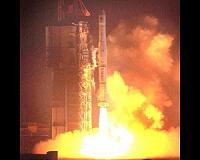 |
Paris, France (ESA) Dec 21, 2010 Galileo's terrestrial nerve centre formally entered service Today. With the first Galileo satellites due to be launched next August, Fucino in central Italy will oversee the running of all the navigation services provided by Europe's global satellite system. The Fucino Galileo Control Centre, 130 km east of Rome, was inaugurated by Antonio Tajani, Vice President of the European Commission for Industry and Entrepreneurship; Jean-Jacques Dordain, ESA Director General; Gianni Letta , Undersecretary of State of Italy; Jan Woerner,DLR Executive chairman; Enrico Saggese, ASI Chairman; Pier Francesco Guarguaglini, Finmeccanica Chairman and CEO and Carlo Gualdaroni,Telespazio CEO. Fucino is one of two Galileo Control Centres - alongside Oberpfaffenhofen near Munich in Germany - to monitor and control the Galileo satellites and ground stations and provide all the information products needed to support the Galileo navigation services. The twin control centres sit at the heart of Galileo's far-flung network of satellites and ground stations distributed worldwide. They have split responsibilities although, with Galileo set to operate continuously, they are fully redundant, meaning that one can step in for the other in case of need. In the initial phase, while the Oberpfaffenhofen centre is in charge of controlling the satellites in space, Fucino holds responsibility for the overall navigation mission. Fucino will process the collected data, generate, transmit and distribute the navigation products through uplink stations connected to the satellites to broadcast signals to users. The Fucino centre will also keep the clocks aboard the individual Galileo satellites synchronised with the time of the overall Galileo system.
How Emperor Claudius prepared the way for Galileo Fucino is also employed by a number of ESA space missions, including serving as the control centre for the GIOVE-B prototype Galileo satellite. The site is ideal for satellite communications because it has plenty of broad flat ground, screened from terrestrial electromagnetic signals by surrounding hills. This distinctive geography is the result of one of the ancient world's greatest feats of engineering: the Romans dug a tunnel to drain much of the lake that originally covered the Fucino basin. This pioneering work of Emperor Claudius was finally completed in 1875, when the rest of the lake was drained using the very same tunnel. The rich soil left behind is today employed for farming. Ground was broken for Galileo's control centre in 2007. The facility was built by Telespazio, which also runs the Fucino ground station. The Fucino control centre, like its German equivalent, will be operated by Spaceopal, which is a 50/50 joint venture between Telespazio and Gesellschaft fur Raumfahrtanwendungen (GfR) mbH, a firm set up by the German Aerospace Center (DLR) to provide operational services for the Galileo system.
Share This Article With Planet Earth
Related Links European GNSS Supervisory Authority (GSA) GPS Applications, Technology and Suppliers
 China Launches Seventh Orbiter For Indigenous Global SatNav System
China Launches Seventh Orbiter For Indigenous Global SatNav SystemXichang, China (XNA) Dec 20, 2010 China successfully launched an orbiter into space from the Xichang Satellite Launch Center in southwestern Sichuan Province at 4:20 a.m. Beijing Time Saturday. It was the seventh orbiter that China has launched for its independent satellite navigation and positioning network, also known as Beidou, or Compass system. It is the 136th flight for the country's Long March series of rocket ... read more |
|
| The content herein, unless otherwise known to be public domain, are Copyright 1995-2010 - SpaceDaily. AFP and UPI Wire Stories are copyright Agence France-Presse and United Press International. ESA Portal Reports are copyright European Space Agency. All NASA sourced material is public domain. Additional copyrights may apply in whole or part to other bona fide parties. Advertising does not imply endorsement,agreement or approval of any opinions, statements or information provided by SpaceDaily on any Web page published or hosted by SpaceDaily. Privacy Statement |